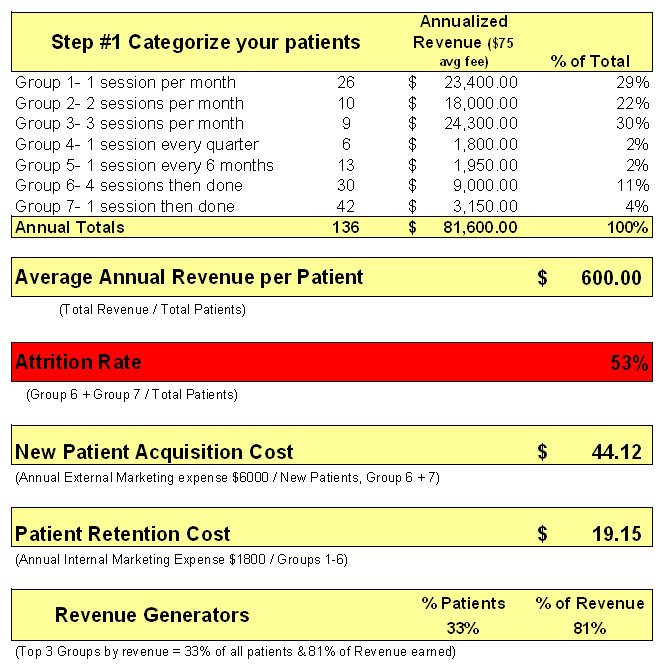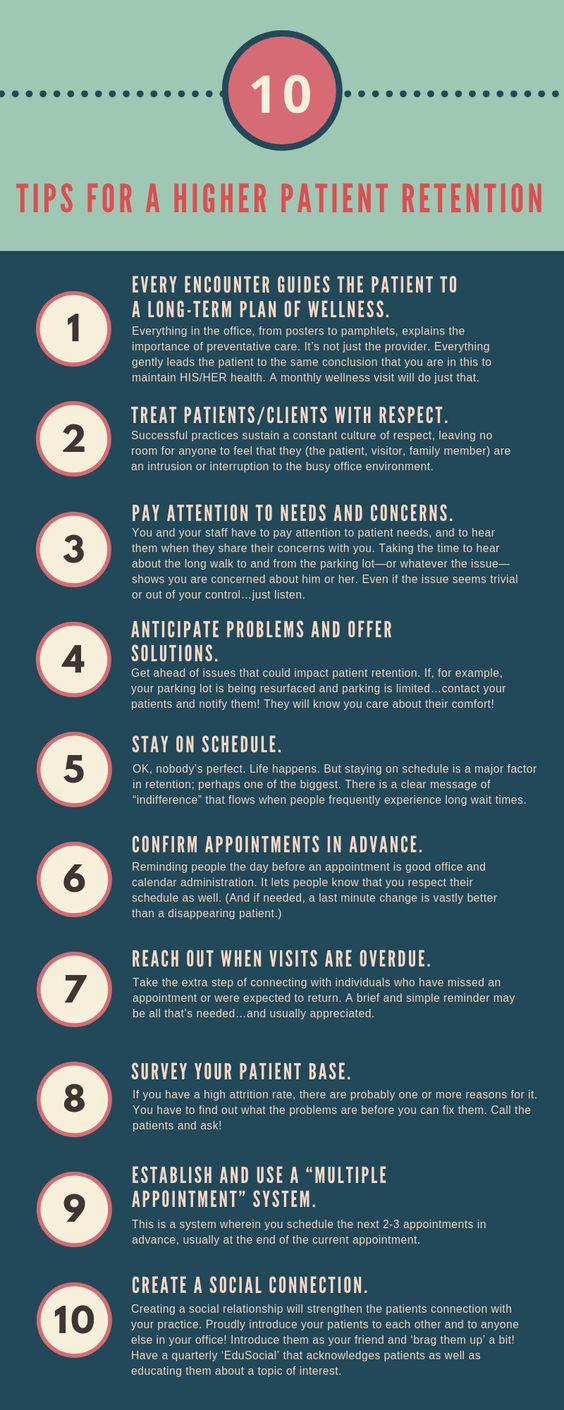How is your practice doing? Summertime is slow for many practitioners, which makes it the perfect time to reflect on the past six months and evaluate what’s been working…or not!
Your vision certainly includes financial success for your practice. Let’s work together to calculate your patient Attrition/Retention rate and improve your bottom line!
What do the numbers tell us?
How many patients do you have listed in your database? How many do you see regularly? How many do you see once or twice, and then never again? Your answer to these questions will help us know where to begin.
Unless your new-patient flow is greater than your attrition rate (patients leaving the practice), your practice cannot grow. No doctor knows her exact attrition rate because most patients change practitioners without letting you know. Patients also move and some pass away.
A better way to evaluate just how many new patients your practice needs each month is to determine the revenue generated by your new patients. Revenue from new patients should account for 25% of gross revenue each month, with a higher percentage for newer practices and a lower percentage for mature practices. In the spreadsheet example below, revenue from new patients accounts for just 15% of total revenue [Groups 6+7 (% of Total)]. 
If you haven’t done this lately, grab a pencil and paper and let’s calculate how many patients you are losing each year and compare that number to your total patient list (groups 1-7) to come up with your attrition rate.
Step #1 – review the past 12 months and categorize your patients into one of 7 groups. The following spreadsheet illustrates the groups.
Your attrition rate is calculated by adding your short-term or new patients and dividing that number by your total patients for the year. In this example, the attrition rate is 53%.
Once you have uncovered your attrition percentage, calculate what that represents in lost revenue. If Groups 6 & 7 were added to group 1 and you saw them once a month, how much more revenue would you have per year?
In this example, it would be (30 + 42) x 12 x $75 = $64,800 – (9000+3150) = $52,650. You would make an additional $52k by converting those patients into regular once a month wellness patients.
It’s one thing to say you have a low % of new patients and quite another to translate that into lost revenue and discover you are losing $52,650 by NOT retaining and converting these patients to monthly wellness visits!
Notice how much it costs to acquire a new patient ($44.12) compared to retaining a patient ($19.15). Money invested on internal marketing is well spent!
All of your efforts to increase new patients will be fruitless, and even frustrating, if you end up with as much or more patient attrition as you gain in new patient volume. If you achieve 10% growth in new patient volume, but you simultaneously experience a 20% loss in your established patient base—the net result is definitely not in your favor.
You can’t afford to take for granted the established relationships with current patients in your quest for new ones.
Your Revenue Generators (groups 1-3), account for just 33% of your total patients, yet 81% of your total revenue!
So, how do you organize your practice to convert more patients into wellness/preventative care and assure higher levels of patient retention?
The Basics of Patient Retention

Nearly 70% of people who take their business elsewhere do so because they perceive an ‘attitude of indifference.’ The goal is to take steps to avoid sending the “indifference” message. The following elements are vital if you want higher patient retention.
- Every encounter guides the patient to a long-term plan of wellness. Everything in the office, from posters to pamphlets, explains the importance of preventative care. It’s not just the provider. Everything gently leads the patient to the same conclusion…that you are in this to maintain HIS/HER health. A monthly wellness visit will do just that.
- Treat patients/clients with respect. Successful practices sustain a constant culture of respect, leaving no room for anyone to feel that they (the patient, visitor, family member) are an intrusion or interruption to the busy office environment.
- Pay attention to needs and concerns. You and your staff have to pay attention to patient needs, and to hear them when they share their concerns with you. Taking the time to hear about the long walk to and from the parking lot—or whatever the issue—shows you are concerned about him or her. Even if the issue seems trivial or out of your control…just listen.
- Anticipate problems and offer solutions. Get ahead of issues that could impact patient retention. If, for example, your parking lot is being resurfaced and parking is limited…contact your patients and notify them! They will know you care about their comfort!

- Stay on schedule. OK…nobody’s perfect. Life happens. But staying on schedule is a major factor in retention; perhaps one of the biggest. There is a clear message of “indifference” that flows when people frequently experience long wait times.
- Confirm appointments in advance. Reminding people the day before an appointment is good office and calendar administration. It lets people know that you respect their schedule as well. (And if needed, a last minute change is vastly better than a disappearing patient.)
- Reach out when visits are overdue. Take the extra step of connecting with individuals who have missed an appointment or were expected to return. A brief and simple reminder may be all that’s needed…and usually appreciated.
- Survey your patient base. If you have a high attrition rate, there are probably one or more reasons for it. You have to find out what the problems are before you can fix them. Call the patients and ask!
- Establish and use a “multiple appointment” system. This is a system wherein you schedule the next 2-3 appointments in advance, usually at the end of the current appointment.
- Create a social connection. Creating a social relationship will strengthen the patients connection with your practice. Proudly introduce your patients to each other and to anyone else in your office! Introduce them as your friend and ‘brag them up’ a bit! Have a quarterly ‘EduSocial’ that acknowledges patients as well as educating them about a topic of interest.
It IS possible to lower the patient attrition rate to just 12%-18% each year. You can do this by following the ten, key elements listed above and by creating both an external and internal marketing plan.
Retaining existing patients while attracting new patients is vital to your practice. A growing practice is important. Retaining patients needs to be of equal importance.
Never underestimate how many patients you actually lose each year. Keep your eyes on the numbers and invest appropriately!
Drop me an email or give me a call if you have any questions. Have a great week!
Alan Gifford, MS
Practice Coach

Very good article. I want to do a self evaluation of my practice for a long time, I just don’t know how. This article is a big help.
I have a question, I have only one database for my patient which is yahoo calendar. Any suggestion for how I could use this data for analysis?
thx
You can still do a detailed analysis like the article suggests. You’ll need to start by totaling your revenue for the past year. Then add up all of the Patient visits you’ve had. Divide revenue by patient visits to arrive at an average earnings per patient visit. Next, look at your Yahoo calendar. Make a list of all the patients you’ve seen. This will be time consuming, but worth it! Once you have all of their names listed on a sheet of paper, go back to the calendar see how many times over the past 12 months you saw each patient. Make a little hash mark by their name for each time you saw them.
When this is done you’ll be able to Group your patients as I suggested. Once the patients are in groups and you’ve calculated your average earnings per patient, you’ll be able to identify where you need to invest more time, energy and marketing dollars! I can make the spreadsheet available for you to plug in your numbers, however, you’ll still need to do the tedious work I just described above! Good luck and let me know if you need more help.